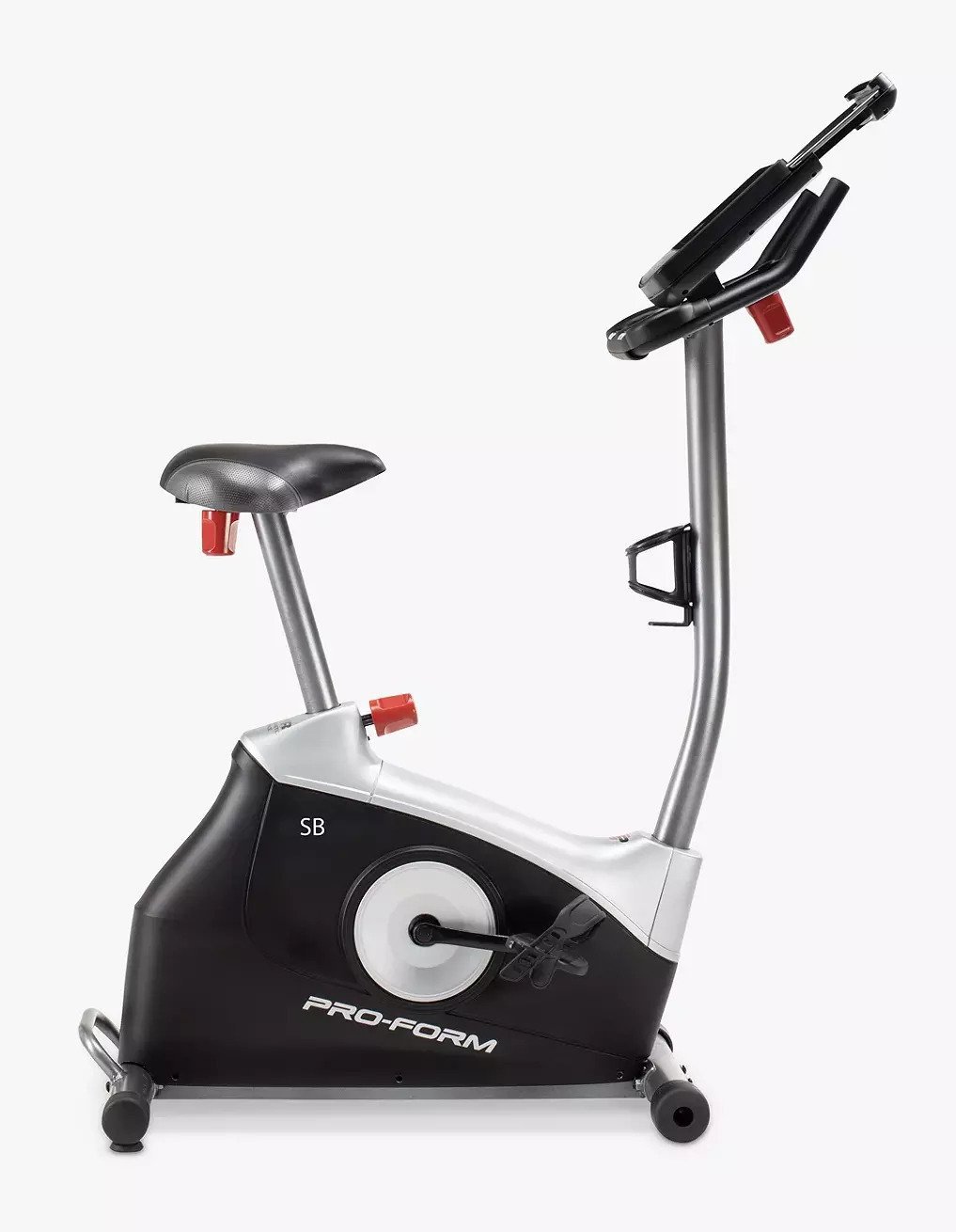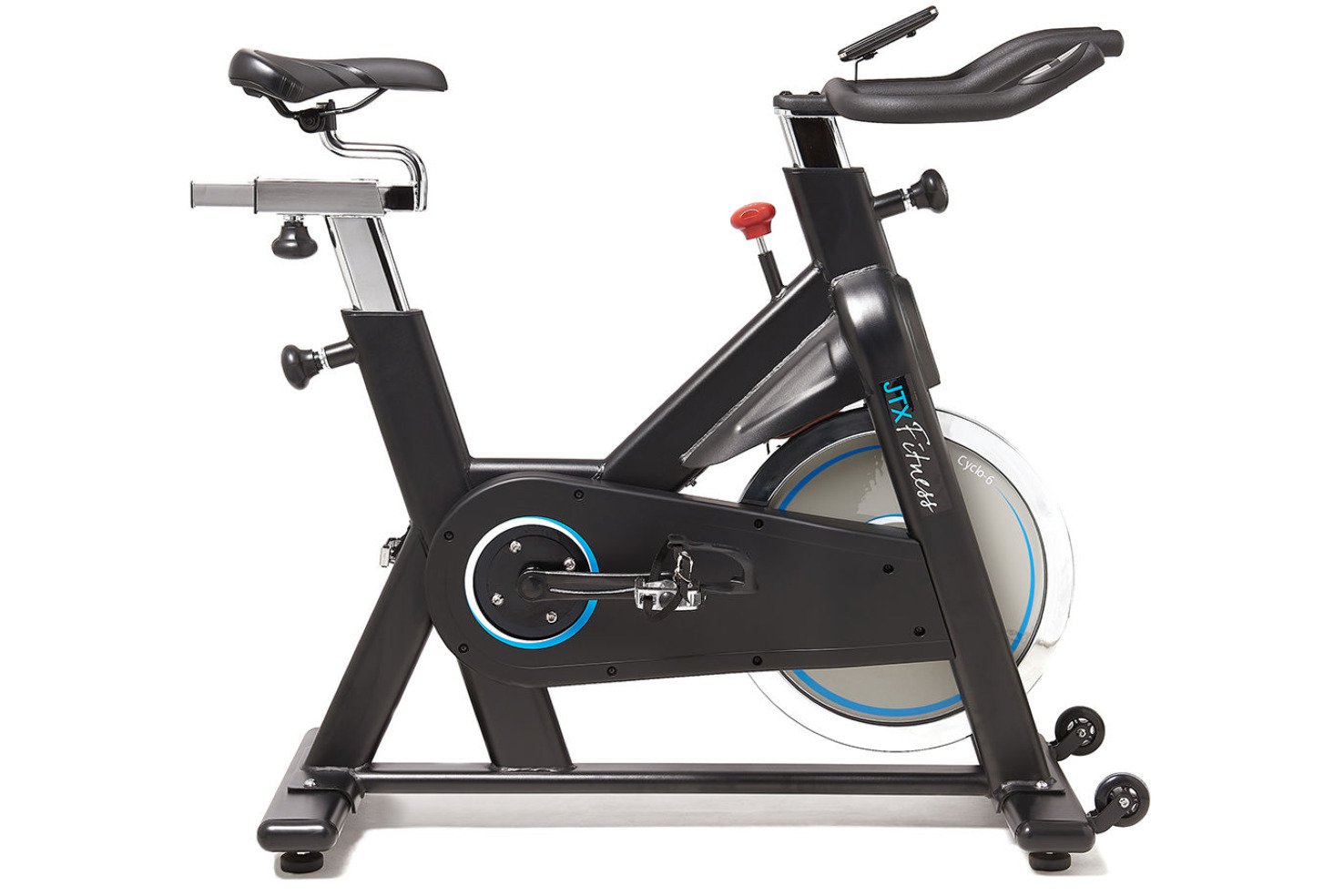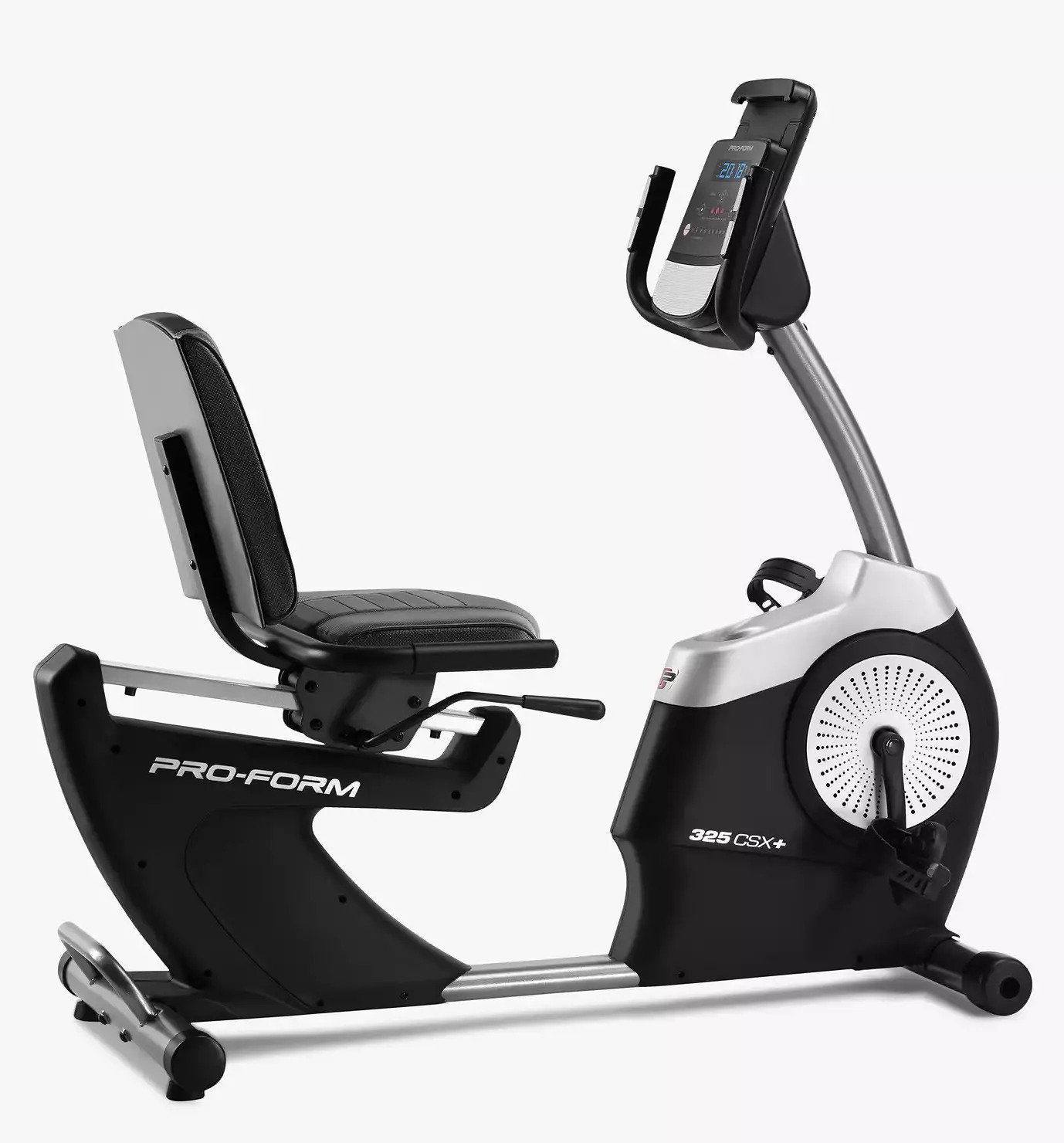Exercise bikes are a great way to stay fit and active without having to leave the comfort of your own home. They come in many different shapes and sizes, and they’ll all help you stay healthy and build up your fitness. However, the different types of exercise bike suit different spaces, lifestyles and riding styles. There are three main types of exercise bike: upright exercise bike, spin bike and recumbent exercise bike.
All of these exercise bikes have different setups and are designed to meet your home and fitness routine’s varying needs. In this article, we will help cut through the noise by explaining the differences between the bikes and running through the key things to consider when deciding which type of bike is right for you, so that you can make an informed decision when you invest in your next - or very first - exercise bike.
What is an upright exercise bike?
An upright exercise bike has a clue in the name, the riding position is upright. This lends itself to a very comfortable riding position. The handlebars are higher than the broad comfortable seat. These are great introductions to exercise bikes or just fitness in general. You can also find folding upright exercise bikes, which are great if you are short on space and need to stow away your bike when not in use. If you decide an upright bike is what you're looking for then check out our post on the Best Upright Exercise Bikes.
What is a spin bike?
A spin bike (also known as spinning bike, indoor cycle, studio bike and racer bike) is performance orientated. The large flywheel is often heavy and requires power to get it moving. Once you have built up speed on a spin bike, you need to maintain the momentum. Unlike on other exercise bikes (or traditional bikes), you are not able to coast. That means that the pedals constantly move when in use. This feature, combined with the more aggressive and hunched over riding position, lends spin bikes to be most suited to cyclists that want to level up their fitness and push their boundaries. You can see our top picks in our Best Spin Bikes blog.
What is a recumbent exercise bike?
Recumbent exercise bikes are the most relaxed type of exercise bike on the market. You are sat down as you would be on a chair, with a backrest, and the pedals are in front of you, unlike both upright and spin bikes, where the pedals are under the seat. This riding position is very comfortable, but it does still mean that you can get a great workout. Although you do not get as much of a core workout, recumbent exercise bikes are still effective at building your fitness and leg strength. Recumbent exercise bikes take up more space than any other type of exercise bike due to their horizontal design. Thinking of going for a recumbent bike? If so, take a look at our favourites in our article on the Best Recumbent Exercise Bikes.
Buying Guide
Now that you know a bit more about each type of exercise bike on offer. Let’s try to help you make an informed decision about which kind of exercise bike is right for you. With so many on offer and such a wide range of price points, it can feel a bit overwhelming. However, this buying guide will highlight the factors to consider when buying, along with the pros and cons of each type.
Riding Position
The exercise bike you decide to buy must be comfortable for your body. The different riding position is one of the most significant differences between upright, spin and recumbent exercise bikes.
A recumbent is the most comfortable type of exercise bike, thanks to back support and a more laid back riding position. Generally, recruitment exercise bikes will not have a traditional bike seat. Instead they have a much larger, flatter seat, which allows you to evenly distribute your weight and remain in relative comfort for long periods.
Spin bikes have a more aggressive riding position. They are the closest to the feeling of riding an actual bike. This is perfect if you are used to being hunched over a road bike’s handlebars or are using your exercise bike to train for a sportive or charity bike ride. The seats are a lot smaller on a spin bike, which reduces chafing and makes it easier to spin the pedals for long periods. However, it is no secret that these narrow seats are not the most comfortable for beginners.
Finally, an upright exercise bike has a riding position somewhere in the middle of a spin bike and a recumbent exercise bike. Due to the handlebars being higher than the seat, you are sat in an upright riding position without the benefit of back support. The seats on upright exercise bikes are more expansive than those found on spin bikes but not as broad as the seats on a recumbent exercise bike.
Workout intensity
The intensity of any workout depends on your baseline fitness. However, if high-intensity workouts are what you are after, then spin bikes are your best bet. They are performance orientated, generally have more resistance levels, and it is easy to stand up and pump the pedals for a full-body workout.
Both upright and recumbent exercise bikes allow for low to medium intensity workouts but do not have the same workout range as spin bikes.
Which areas of the body do they target?
Indoor cycling is a great way to tone your legs, bum and stomach. You can also mix up your workout on a spin bike by standing up out of the seat and using your upper body to transfer even more power into the pedals.
Spin bikes and upright exercise bikes give your core a good workout as it is engaged throughout your ride to maintain balance. However, the act of pumping your legs up and down does require your core to do some work, so recumbent exercise bikes will also tone your stomach without any additional pressure or stress on your back.
Calorie burn and weight loss
Not many of us buy an exercise bike for the sheer love of cycling alone. We want to know that our hard work is paying off and will burn calories and lead to weight loss.
There is a misconception that a recumbent exercise bike uses up fewer calories. This is false. You burn precisely the same amount of calories from a workout of the same intensity on a recumbent, upright and spin bike. The critical thing here is the intensity of your workout. Due to their design, spin bikes push you to increase your workout intensity, hence why this is the favoured exercise bike of choice for fitness fanatics.
Here is a rough guide of how many calories you could burn on an exercise bike depending on your weight and the workout intensity:
- Person weighing 57kg (125 pounds): 210 calories at moderate intensity & 315 calories at high intensity.
- Person weighing 70kg (155 pounds): 260 calories at moderate intensity & 390 calories at high intensity.
- Person weighing 84kg (185 pounds): 310 calories at moderate intensity & 465 calories at high intensity.
Consistency and workout intensity is vital to ensure that your exercise bike sessions result in calorie burn and weight loss. We've written an in-depth post on how exercise bikes help weight loss here.
Which bike is best for home use?
When considering the best exercise bike for your home, you need to think about how much space you have and whether you have enough room to be able to leave your exercise bike out or not. Generally, it is only upright exercise bikes that come in versions that fold away. If you're short on space then you should check out our post on the Best Folding Exercise Bikes!
Recumbent exercise bikes are the largest and take up the most space. Due to their design, they are longer and wider than both spin and upright exercise bikes. You can find foldable recumbent exercise bikes, which are a bit easier to stow away.
The average dimensions for a typical upright or spin bike are:
- Length: 89cm - 122cm
- Width: 46cm - 66cm
- Height: 64 cm - 76cm
If you are looking for an exercise bike that you will need to move around, then look out for those with small wheels on their feet. This makes them incredibly easy to drag (without worrying about damaging the floor).
Cool technology and features
The technology on exercise bikes varies widely. You will usually find that the most expensive models have the most features and connectivity options. As a minimum, you will want a screen that tracks your speed, distance and calories burned. However, if you are serious about your training, it is worth spending a little more to get more detailed workout feedback.
Brands such as Peloton and Echelon have made ‘smart’ spin bikes very popular. They are expensive, however, so if you want to avoid paying the extra for a fancy wide LCD screen then look for an exercise bike with Bluetooth and ANT+ connectivity. This allows you to seamlessly sync your exercise bike with your laptop, tablet or phone, which enables you to make use of third party apps such as Zwift. Ideally, you will want the exercise bike to have a tablet holder to make the most of these features.
A lot of exercise bikes come with pulse monitors built into the bars. This is an excellent way for you to track your fitness as well as play around with HR (heart rate) zone workouts. You will find that spin bikes tend to have more technology packed into them. One reason is that they are performance orientated, and by connecting to apps, you can ride with friends and follow more intense group spin sessions.
Budget
As mentioned above, you will find that the most feature-packed exercise bikes are more expensive. So, you need to decide how many of these features matter to you. Also, do not forget that no matter how much money you spend on an exercise bike, you still must have the discipline to use it consistently. If you are new to indoor cycling, you may be better off going for a cheap exercise bike - you can see our favourites in our article on the Best Cheap Exercise Bikes. Exercise bikes start at around £100 ($140) and can go well into the thousands. Those around the £100 ($140) mark are usually upright exercise bikes and often foldable. These are a great entry into the world of indoor cycling. Especially if you do not have much space or do not yet know if indoor cycling is right for you. As you build up your fitness, you will want to start getting more fitness data and even taking part in online workouts and group rides. This is when you'll need to consider spending a bit more to get a quality spin bike.
Spin bikes are the most expensive of the exercise bike types. The basic models start at around £250 ($350), but as more and more features are added, their cost goes into the thousands of pounds ($1,400+).
Conclusion: What type of exercise bike should you get?
Ultimately, it is up to you which type of exercise bike will fit your home and lifestyle best. If you are looking for an exercise bike to use during high-intensity workouts, then a spin bike is the best option for you. However, if you prefer the more relaxed riding position of an upright exercise bike, you can still use the resistance levels to get a decent workout. More affordable upright exercise bikes are also often foldable, perfect if you are tight on space. Finally, the recumbent exercise bike is perfect for you if you are looking for a low-intensity workout, need a little extra lumbar support, or build up your health and fitness using low-intensity exercise.
Now you know the difference between the different types of bike, you should check out our ultimate guide to buying an exercise bike here.
For the rest of your man cave needs and desires, why not explore our site or head over to the Exercise Bikes section to see more posts and recommended products!
Affiliate disclaimer: on some or all of the products above, we receive a small commission if you make a purchase via our site. This does not impact the price you pay, but it allows us to keep helping people by writing these reviews, so thank you!




